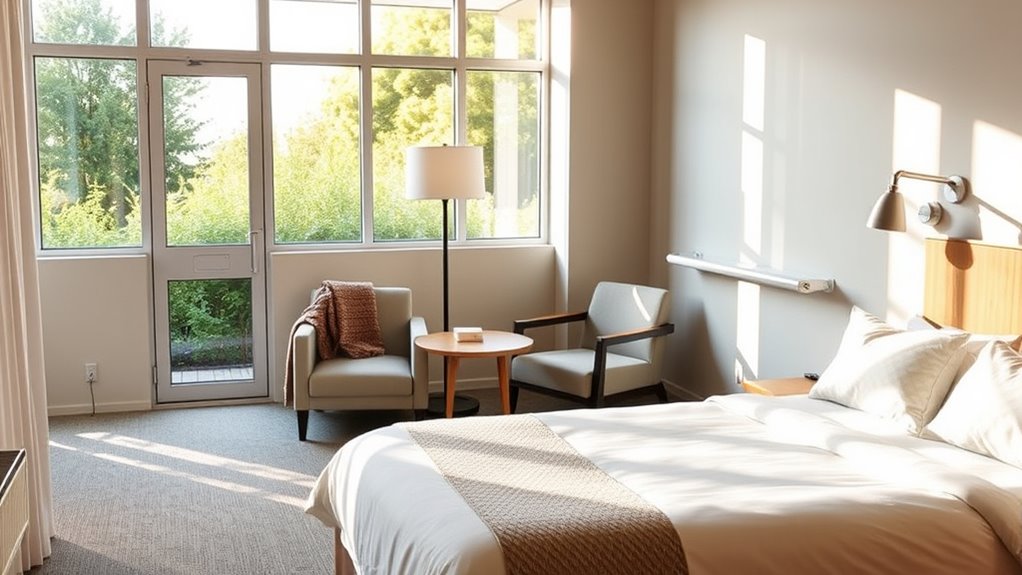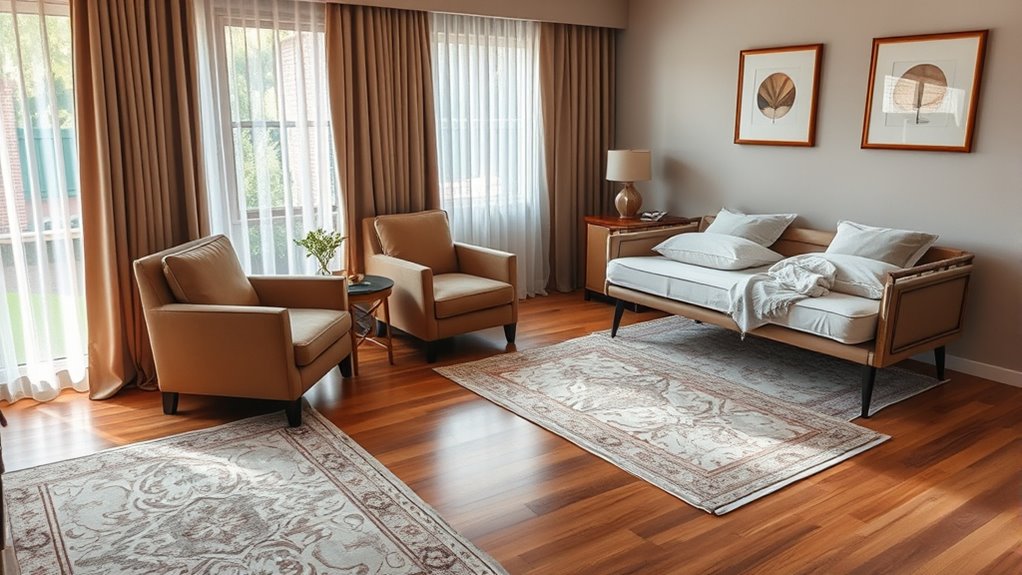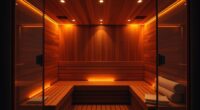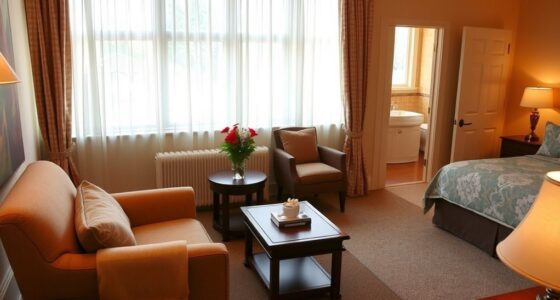Guest suites that double as care spaces are versatile options that blend comfort, safety, and independence. They typically feature easy-access storage, non-slip flooring, adjustable lighting, and personalized touches to create a homelike atmosphere. These spaces often include accessibility upgrades like wider doorways and grab bars, along with technology for safety and monitoring. If you want to learn more about designing or choosing such multi-purpose spaces, options to enhance comfort and independence, keep exploring further.
Key Takeaways
- Design the suite with accessible features like widened doorways, grab bars, and non-slip flooring for safety and mobility.
- Incorporate privacy elements such as lockable doors or separate entrances to balance independence and caregiving.
- Integrate technology like emergency call buttons, motion sensors, and easy-to-use communication tools for safety and monitoring.
- Maximize natural light and adjustable lighting to promote well-being, comfort, and a relaxing atmosphere.
- Include personal touches, cozy furnishings, and social spaces to foster a home-like environment supporting emotional comfort.

Guest suites are increasingly being transformed into versatile care spaces that meet the needs of aging family members or those requiring additional support. This trend reflects a practical and compassionate approach to caregiving, allowing your loved ones to maintain independence while staying close. When designing a guest suite as a care space, think about creating a comfortable yet functional environment that adapts to evolving needs. Incorporate features like easy-to-reach storage, non-slip flooring, and adjustable lighting to promote safety and ease of use. You want your loved one to feel welcomed, not like they’re in a clinical setting, so focus on blending comfort with practicality.
A key consideration is privacy and independence. Even if you’re there to assist, your loved one should have a sense of autonomy. Consider installing a lockable door or a separate entrance if possible, so they have control over their space. Adding personal touches such as their favorite artwork, cozy bedding, or familiar furniture can help create a homey atmosphere that encourages relaxation. It’s also important to think about accessibility—widen doorways, install grab bars, and consider a walk-in shower if mobility is limited. These modifications make daily routines safer and easier, reducing the risk of falls or accidents.
Technology plays an essential role in transforming guest suites into effective care spaces. Simple devices like emergency call buttons, motion sensors, or video monitoring systems can provide peace of mind, allowing you to stay connected without being intrusive. Make certain that communication tools are easy to operate and accessible. Additionally, setting up a dedicated space for medical supplies, medications, and health monitoring equipment keeps everything organized and within reach. This not only enhances safety but also streamlines daily routines, making caregiving less stressful.
Lighting is another key element. Natural light can lift spirits and improve mood, so maximize windows and use light, airy curtains. Supplement with adjustable artificial lighting to ensure the space is well-lit during nighttime or cloudy days. Comfortable seating and a small table create a welcoming area for socializing, reading, or hobbies, which are essential for mental health and well-being. Think about incorporating a small kitchenette or snack station if space allows, so your loved one can easily prepare drinks or snacks without needing to navigate a larger kitchen.
Furthermore, understanding cheating and its implications can help create a more supportive environment, especially when addressing emotional and psychological needs of your loved one. Ultimately, transforming a guest suite into a care space requires thoughtful planning that balances safety, comfort, and independence. By paying attention to these details, you create an environment where your loved one feels secure, respected, and at home—an essential foundation for their well-being and your peace of mind.
Frequently Asked Questions
What Are the Legal Requirements for Converting Guest Suites Into Care Spaces?
You need to check local zoning laws and building codes to convert guest suites into care spaces. Typically, you’ll require permits, verify the space meets safety standards, and possibly upgrade electrical, plumbing, and ventilation systems. You might also need to comply with health and safety regulations specific to care facilities. Consulting with local authorities or a legal expert helps ensure you meet all requirements and avoid potential fines or penalties.
How Do I Ensure Privacy for Both Guests and Caregivers?
You make privacy your top priority by installing soundproofing and secure locks, creating invisible walls that respect each individual’s space. Use curtains or partitions to give flexibility and control, like gentle breezes offering comfort. Establish clear policies for caregivers and guests, ensuring everyone knows their boundaries. Regularly review your privacy measures, like tending a garden, so they stay effective and nurturing, fostering trust and peace of mind for all involved.
What Safety Features Are Essential in a Care-Friendly Guest Suite?
You should install grab bars, non-slip flooring, and adequate lighting to guarantee safety. Consider adding emergency call buttons or cords within easy reach, along with accessible door handles and wide pathways for mobility aids. Use smoke and carbon monoxide detectors, and ensure proper ventilation. Regularly check electrical outlets and appliances for safety. These features help protect both guests and caregivers, creating a secure, comfortable environment for everyone involved.
How Can I Modify My Home for Accessibility in These Spaces?
You can make your home more accessible by removing trip hazards like loose rugs and clutter, even if it feels like overkill. Widen doorways for wheelchair access, install lever handles instead of knobs, and add ramps where needed. Brighten spaces with good lighting and consider installing grab bars in bathrooms. These small changes create a welcoming, safe environment, proving that accessibility isn’t just a necessity — it’s a way to show you care.
What Are the Costs Associated With Transforming Guest Suites Into Care Areas?
Transforming your guest suites into care areas can cost between $5,000 and $20,000, depending on the modifications needed. You might spend on installing grab bars, ramps, or accessible bathrooms, along with medical equipment if necessary. Keep in mind that renovation costs vary based on the home’s size, existing infrastructure, and your specific needs. Planning ahead helps you budget effectively and guarantees the space meets safety and accessibility standards.
Conclusion
By transforming guest suites into care spaces, you create versatile environments that serve multiple needs. Did you know that over 60% of homeowners now prioritize adaptable spaces for both visitors and caregiving? This trend not only maximizes your home’s functionality but also offers peace of mind knowing you can effortlessly support loved ones. Embracing this dual-purpose design ensures your space remains welcoming, practical, and ready for whatever life brings.









